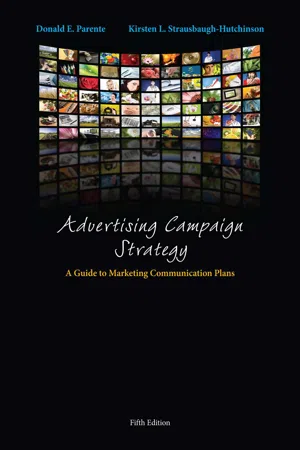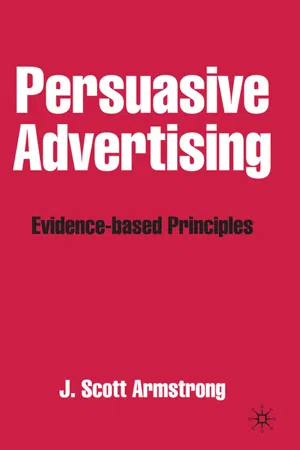Marketing
Advertising strategy
Advertising strategy refers to the plan and approach used to promote a product or service through various advertising channels. It involves identifying target audiences, selecting the most effective advertising mediums, and crafting compelling messages to achieve marketing objectives. A well-defined advertising strategy helps to maximize the impact of advertising efforts and drive consumer engagement.
Written by Perlego with AI-assistance
Related key terms
1 of 5
11 Key excerpts on "Advertising strategy"
- eBook - ePub
What's in a Name?
Advertising and the Concept of Brands
- David M Jones, Jan S. Slater(Authors)
- 2014(Publication Date)
- Routledge(Publisher)
Added values are built over time. They are developed by the consumer’s satisfaction with the brand and reinforced through advertising. This is the power of Coca-Cola, Kodak, McDonald’s, and thousands of other brands. The advertising’s focus on added values of the brand helps to strengthen positive feelings about it. Advertising builds these added values by reinforcing positive experiences, providing user imagery that is relevant to the consumer, and demonstrating the effectiveness of the brand as well as its attractiveness. While the brand must have a coherent totality—the totality of what the brand offers to satisfy the consumer’s wants and needs, both functional and nonfunctional—advertising is an integral part of building added values and strengthening the appeal of the brand.The Development of a Strategy
Now that we have established the basis of advertising and its limitations, we can turn our attention to the Advertising strategy. What is a strategy? Basically, the word comes from the military. The dictionary definition is “the science and art of military command exercised to meet the enemy in combat under advantageous conditions.”14 There is an obvious analogy between the military and advertising uses of the word. Brands battle in the marketplace, a very competitive zone. Much of the language is similar, with adjectives like “offensive,” “defensive,” and “aggressive.” We discuss “marketing warfare” and refer to category competition as the “cola wars” or “toy wars.” The key to winning—or overtaking the enemy—is to plan the attack that provides the strongest competitive advantage. The plan of attack in advertising is the strategy. Therefore, we can define Advertising strategy as a method of identifying a plan of action that provides the brand a competitive advantage via advertising. The strategy provides an overview of the situation and direction with respect to which target has the greatest potential, what needs to be said to this audience to influence them, and the basic intent of the advertising.Why is an Advertising strategy so important? There are four reasons. 1. A strategy encourages clear and logical thinking - eBook - PDF
Advertising Campaign Strategy
A Guide to Marketing Communication Plans
- Donald Parente, Kirsten Strausbaugh-Hutchinson(Authors)
- 2014(Publication Date)
- Cengage Learning EMEA(Publisher)
It is general in nature and takes place over time. A good strategy is flexible and anticipates consumer responses and competitive reactions. This chapter has been written in part by JoAnn Anderson, brand and multiplatform research analyst at CNN in New York City. JoAnn has a background in television advertising, social media, and entertainment marketing. Currently, her role encompasses strategizing in the digital and social spheres, where her perpetual interest in how brands innovate and evolve with their fans serves her well. 147 Copyright 2015 Cengage Learning. All Rights Reserved. May not be copied, scanned, or duplicated, in whole or in part. Due to electronic rights, some third party content may be suppressed from the eBook and/or eChapter(s). Editorial review has deemed that any suppressed content does not materially affect the overall learning experience. Cengage Learning reserves the right to remove additional content at any time if subsequent rights restrictions require it. It was noted in the previous chapter that there is a distinct difference between marketing and communication objectives. And it was made clear that a comprehensive campaign requires both. It should be no surprise then that you need to outline both a strong marketing strategy and a solid communication strategy if you ’ re going to reach your goals. Marketing strategy: Recall that marketing objectives originate with the client. They often revolve around sales, business growth, profits, traffic, transactions, bookings, gains and losses, and so forth. As such, they require a marketing strategy focused on the careful management of the 4P ’ s of marketing: product, price, place, and promotion. To achieve their goals, companies can modify their production process and materials, control vol-ume, and improve or expand their product offerings. They can manipulate pricing structure to offset costs, increase profit margins, as well as to attract or deter particular consumer groups. - eBook - PDF
Advertising & Promotions NQF2 SB
TVET FIRST
- A Mentasti(Author)
- 2013(Publication Date)
- Macmillan(Publisher)
A lot of this promotion is subtle, such as the look of the buildings or the way the staff communicate with customers. What are promotional activities within a strategy? A company launching a new product will need to tell the potential customers about the new product. The company will need to promote the idea of this new product. This will involve lots of communication. The strategy will include many ways of talking to the customer and so will also include a wide range within its promotional mix. A company tries to control this communication by using different promotional tools. A company will use a promotional mix of various tools to communicate and attempt to persuade customers that their new product is better than any others available on the market. This promotional mix will be used in a promotional strategy. The promotional mix • Advertising – a message about a product on T.V. in magazines, on radio or in the newspapers. • Publicity – a news article that talks about a company in a newsy type of way Unit 19.1: The nature of promotional activities Module 19 122 • Personal selling – a sales person persuading you to buy the product • Direct marketing – a letter sent to you by post to encourage you to buy • Sales promotion – short-term activities designed to encourage immediate purchase A marketing manager must be aware of a total set of ways to communicate with a customer. For example, there will be many choices such as an advertisement on T.V., a radio announcement, a poster in a store, a sales person who telephones a potential customer or a pamphlet handed to a person on a street corner. - eBook - PDF
- Patrick De Pelsmacker(Author)
- 2022(Publication Date)
- Edward Elgar Publishing(Publisher)
In an advertising audit, all forms of advertising the brand currently uses (TV ads, online natives, outdoor, etc.) are screened to assess their consistency with overall strategy, as well as their internal consistency. The audit can be carried out on the basis of an internal analysis, but also target group members could be involved. On the basis of this advertising audit, the Advertising strategy for a brand and/or instruments used can be adjusted. Competitor Advertising strategy research screens competitive ads to judge competitive advertising strategies in order to define target groups and positioning strategies more clearly for the company’s own products. In addition, competitive media strategies and media mixes can be studied to get an idea of the competitors’ advertising budgets and shares of voice, target groups, positioning, and strategies. Advertising content research is used to help advertising creatives generate ideas about the content of new advertising stimuli. When a new campaign is to be launched, brainstorm- ing sessions can be organized, involving creatives, advertisers, and con- sumers. Thought-starter lists, in which a multitude of potential benefits of ADVANCED INTRODUCTION TO ADVERTISING 78 the brand or product to be promoted are listed, may also be used to get the process underway. Segmenting, targeting, and positioning Consumers have different characteristics, different needs, and different ways in which they want to satisfy their needs. Therefore, companies have to find out in what way market segments are different with respect to their products and brands, which target markets to select, and how to approach them. Developing a strategy to sort this out is referred to as the segmenting–targeting–positioning (STP) process. - eBook - ePub
Marketing Communication
A Critical Introduction
- Richard Varey(Author)
- 2002(Publication Date)
- Routledge(Publisher)
Goal setting for advertising is contingent upon market conditions and provider–product situation. Often, sub-goals have to be specified as means of accomplishing the goals. We will examine goal-setting further in the next chapter.CREATIVE STRATEGIES
Message strategy or creative strategy is concerned with what is to be said in an advertisement. Laskey et al . (1989) produced a typology of informational or transformational advertising concepts (Table 14.1 ).Simon (1971) reviewed copywriters’ work to classify advertisements based on the view that product–brand characteristics each require particular methods of ‘activating’ the customer to buy through exposure to advertising. Table 14.1 summarizes nine creative strategies.EXECUTIONAL FORMATS
The executional format is the technique used by an advertiser for presenting messages. This is concerned with how something is said to someone, i.e. the content of an advertisement. McEwen and Leavitt's (1976) framework for describing television advertisements in terms of stylistic features shows a range of ways of saying something that has been observed through content analysis in TV advertising (Table 14.2 - eBook - PDF
- Robert F. Everett(Author)
- 2008(Publication Date)
- Praeger(Publisher)
They develop a cute slogan that they think people will remember and dump that message out into the market- place through whatever advertising media they can afford. Your message is way too important to be formulated in this manner. I suggest that your try to come up with some yourself. Then ask your employ- ees, customers, friends, and family to make suggestions. Then, before you imple- ment one, try it out on some of your customers and get some feedback. Media Strategy Media strategy consists of three components: . The selection of advertising media . The extent of use of those media . The timing of that use. The rest of this chapter is concerned with these issues. 136 The Entrepreneur’s Guide to Marketing BUDGETING FOR PROMOTION Advertising can be a ‘‘black hole’’ for your money. There is a vast array of choices and, in general, the more you do, the better your sales. But before you begin to develop your advertising program, you are well advised to develop a preliminary budget for that effort. This budget will provide initial guidance in your choice of media and frequency. The most important idea regarding budgeting for your promotional efforts is that: Marketing is an investment, not an expense There are three common methods that companies use to determine their marketing budgets. These are commonly referred to as percentage of sales, competitive parity, and objective-task. Percentage of Sales Method In using the percentage of sales method, you decide what percentage of your gross sales you can appropriately assign to the marketing function and simply spend that. This method is simple, straightforward, and predictable. The only problem is that it is conceptually and operationally backwards. The purpose of promotion is to generate sales. It is an investment in the future sales for your products and services. The percentage of sales method turns marketing into an expense—part of the variable cost of producing a product. - eBook - PDF
- Dawn Iacobucci(Author)
- 2021(Publication Date)
- Cengage Learning EMEA(Publisher)
All Rights Reserved. May not be copied, scanned, or duplicated, in whole or in part. Due to electronic rights, some third party content may be suppressed from the eBook and/or eChapter(s). Editorial review has deemed that any suppressed content does not materially affect the overall learning experience. Cengage Learning reserves the right to remove additional content at any time if subsequent rights restrictions require it. 194 be devised to capture whether that goal was attained. A marketing research project could easily measure the pre- and post-advertising attitudes in the relevant target segment to see whether the attitudes have been enhanced. But when the goal is to strengthen the brand image, the CEO cannot be flipping through this quarter’s sales figures, hoping to see an increase. That is a mismatch between the goal and its assessment, and it would be unfair to whine that advertising wasn’t working. So what is advertising? Why do we need it? And how do we do it well? 11-1 What Is Advertising? Advertising is the primary means by which a company communicates with its customers about its products, brands, and position in the marketplace. Product, price, and place also signal a brand’s positioning, and certainly all these signals need to tell a coherent story. If ads claim that a brand is an exclusive, premium brand, the product needs to be of high quality, priced relatively high, and distributed relatively exclusively. But while the rest of the marketing mix is important, advertising is the most direct communication link. For many people, the word “advertising” connotes television commercials, and certainly this is a fun form of advertising. TV commercials and print ads (in magazines, billboards, online banners and pop-ups) represent much of the typical advertising budget. But compa-nies advertise their brands in everything they do, including event sponsorship, social media activities, the packaging that encloses their products, etc. - eBook - PDF
- Charles Lamb, Joe Hair, Carl McDaniel, , Charles Lamb, Charles Lamb, Joe Hair, Carl McDaniel(Authors)
- 2020(Publication Date)
- Cengage Learning EMEA(Publisher)
Promotion is a vital part of the marketing mix, informing consumers of a product’s benefits and thereby positioning the product in the marketplace. As Exhibit 15.1 shows, the marketing manager deter- mines the goals of the company’s promotional strategy in light of the firm’s overall goals for the marketing mix— product, place (distribution), promotion, and price. Us- ing these overall goals, marketers combine the elements of the promotional strategy (the promotional mix) into a coordinated plan. The promotion plan then becomes an integral part of the marketing strategy for reaching the target market. The main function of a marketer’s promotional strat- egy is to convince target customers that the goods and services offer provide a competitive advantage over the competition. A competitive advantage is the set of unique features of a company and its products that are perceived by the target market as significant and superi- or to those of the competition. Such features can include high product quality, rapid delivery, low prices, excellent service, or some feature not offered by the competition. Promotional strategies have changed a great deal over the years as many targeted customer segments have be- come more difficult to reach. Informative television ad- vertisements are no longer enough, forcing marketers to think more creatively. Most campaigns utilize a variety of tactics—such as digital paid media, social media, and influencer marketing—in addition to more traditional media like television and print. Spotify is an example of a company that uses data analytics to develop campaigns and also to connect campaigns to pop culture. For ex- ample, consider Spotify’s “Thanks, It’s Been Weird” campaign, which was inspired by major events going on in the world, such as the Brexit vote. Throughout the campaign, a data-driven approach was used to highlight interesting music streaming trends in 14 global markets. - eBook - PDF
Persuasive Advertising
Evidence-based Principles
- J. Armstrong(Author)
- 2010(Publication Date)
- Palgrave Macmillan(Publisher)
Mere exposure 8. Attention The principles under each of the three major categories (Strategy, General tactics, and Media-specific tactics) are presented in an order that reflects a natural progres- sion in the design process. They begin with the more general issues and move to the more specific. While Persuasive Advertising is designed to be read from cover to cover, it also serves as a reference. To aid in using the book, each of the ten sections summa- rized in Exhibit C ends with a checklist of principles. Key concepts are listed in the Subject index to help you find principles relevant to a specific problem. Similarly, a Names index might help you to track down studies or sayings. The Glossary provides explanations of key terms used in the book. Finally, you will find a “persuasion principles map” on the last page (page 388). Strategy Advertising says to people, ‘Here’s what we’ve got. Here’s what it will do for you. Here’s how to get it. Leo Burnett, 1940s The “Strategy” section is organized into four areas: Information is widely used in advertising. Consider an ad for a car: “This car has 8 cylinders and goes 200 miles per hour.” Influence presents information in a way that motivates customers. For example, an ad using a scarcity principle might read: “This car is a limited edition—only 300 will be made.” Emotion comes into play in the process of convincing customers who already have sufficient product information to make a purchase. “Feel the thrill of speed in this sports roadster.” Mere exposure is applicable when an ad provides no information or emotion— only the product, brand name, or logo. “This concert was sponsored by Honda.” These basic strategies are not mutually exclusive. All four might be incorporated into a campaign. 26 1. Information Advertise: “To inform another; to give intelligence.” Samuel Johnson, A Dictionary of the English Language, 1755 Most ads include two or more pieces of information and only 16 percent include none. - eBook - PDF
Principles of Marketing
A Value-Based Approach
- Ayantunji Gbadamosi, Ian Bathgate, Sonny Nwankwo(Authors)
- 2013(Publication Date)
- Bloomsbury Academic(Publisher)
9 PHILLIPS & CLEWS 265 Once all of the above have been taken into consideration, the marketing manager selects the most suitable communications elements from the marketing communi-cations mix in order to achieve the communication objectives (for example, to persuade, remind, reinforce). the marketing communications mix Marketers rarely use only one method of communication to reach their target audi-ences. Ideally the elements selected from the diagram in Figure 9.6 should, once put into motion, seamlessly merge to present one cohesive brand message – much as the diagram would blur into one visual mass if it were spun at speed. Advertising Advertising comprises structured impersonal messages which usually inform, persuade or remind consumers about products, services or ideas. They are paid for by the organization initiating the advertisement. There are many ways in which advertising can be presented to consumers. Tradi-tionally, advertising is delivered through media such as TV, newspapers, magazines, posters, bill boards, radio, cinema, vehicles and transit boards. For example, the Example 9.2: Tesco prepares for price war to communicate its customer value strategy Tesco started out as an East End market stall and made its name on a unique selling strategy of ‘piling them high and selling them cheap’ to a generation of cash-strapped housewives. It has since grown to crush its rivals, achieving the ‘No. 1 spot’ as Britain’s biggest supermarket and outper-forming Asda (No. 2) and Sainsbury’s (No. 3). Riding on a wave of growth against the tide of a sluggish economy, with profits topping £2 billion a year, the company in 2012 invested £1 billion to face off fierce competition from rival chains. Apart from its expansion strategy of ‘being everywhere’, it has continued to deepen its distinct ranges of own-brands, from Value to Finest , which are priced to attract all types of shoppers. - eBook - PDF
- Cathy H. C. Hsu, Tom Powers(Authors)
- 2002(Publication Date)
- Wiley(Publisher)
12 Marketing Communication: Advertising (Photo courtesy of W Hotels.) When you have finished reading this chapter, you should be able to: ■ Describe the major components of marketing communication. ■ Identify the appropriate types of communication strategy under different circum- stances. ■ Explain the objectives of promotion. ■ Discuss the five key considerations in advertising planning. ■ Identify four advertising audience segments. ■ Understand advertising media characteristics. ■ List the major media used in advertising. 268 Chapter 12 / Marketing Communication: Advertising The terms “promotion” and “communication” are sometimes used interchangeably in marketing. Because marketing communication, or promotion, includes activities such as advertising and selling, it is the element of the marketing mix many people think of first when marketing comes to mind. Indeed, some people confuse promotional activities with marketing. They think that selling or advertising is marketing. We saved our consideration of communication to end the discussion of the marketing mix to emphasize that the success of marketing communication depends on the products and services offered, the place in which they are offered, and the price at which the offer is made. However, this is not to say that promotion is not as important as the other three elements of the marketing mix. Actually, promotion is so important that we devote two chapters to it. In this chapter we consider advertising, and in the next we examine sales promotion, public relations and publicity, and personal selling. Before we discuss advertising, however, it is appropriate to introduce the major forms of marketing communication. Communication Mix The communication mix includes advertising, sales promotion, public relations and publicity, and personal selling. All but personal selling are methods used to address mass audiences.
Index pages curate the most relevant extracts from our library of academic textbooks. They’ve been created using an in-house natural language model (NLM), each adding context and meaning to key research topics.










